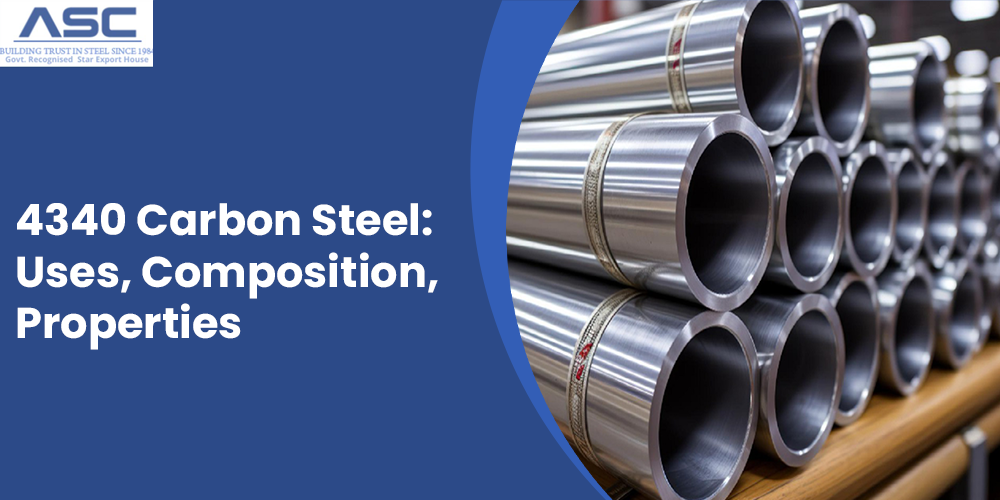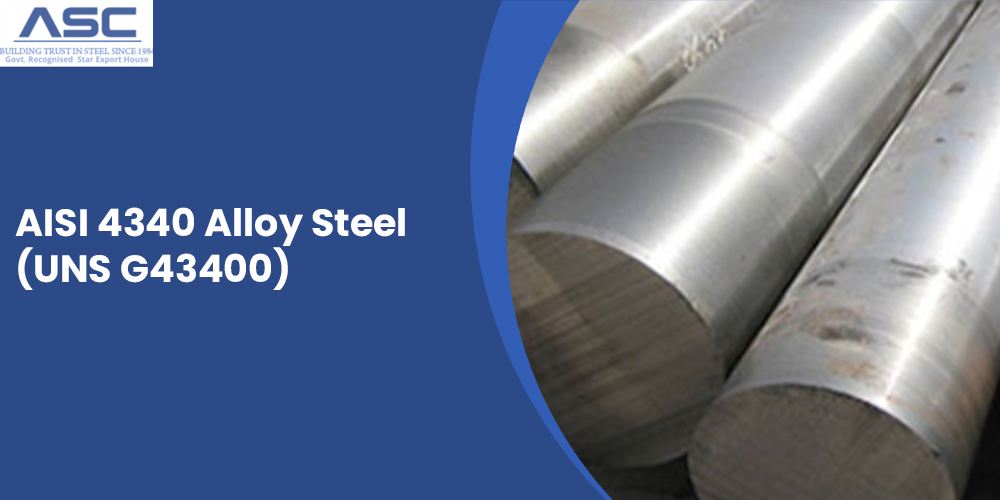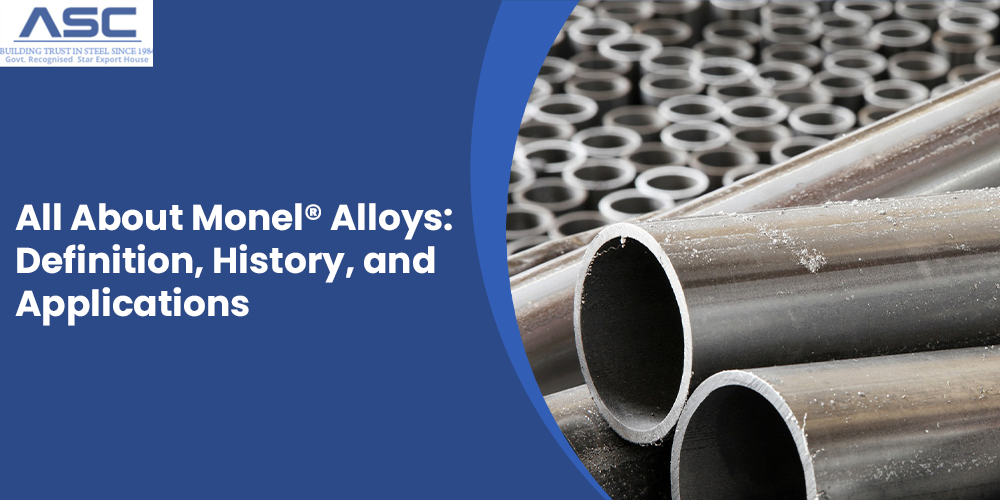4340 Carbon Steel: Uses, Composition, Properties
by AMC
Posted on July 22, 2024 at 12:40 PM

4340 carbon steel is a versatile alloy steel known for its strength, toughness, and high fatigue resistance. This type of steel is commonly used in applications requiring good wear resistance and the ability to withstand heavy loads.
In this blog, we'll explore the various uses, chemical composition, and key properties of 4340 carbon steel, helping you understand why it is a popular choice in many industries.
What Is 4340 Carbon Steel?
4340 is an American standard carbon steel renowned for its high-strength properties. It is ferromagnetic, meaning its magnetic properties vary with its phase. The limited alloying elements in 4340 steel result in a highly magnetic material due to its iron content.
What Is 4340 Carbon Steel Used For?
Due to its strength, 4340 carbon steel is used in many structural and high-strength applications. Common uses include transmissions, gears, shafts, landing gear, hydraulic systems, automotive frames, and fasteners. It is especially valued in heavy-duty applications such as landing gear and other structural components.
How Is 4340 Carbon Steel Made?
The production of 4340 carbon steel involves several carefully controlled steps to ensure the final product has the desired properties. Here's a simplified overview of the process:
- Melting the Elements: The process begins by weighing and adding iron and alloying elements to an electric furnace. This step takes up to 12 hours, during which all elements are melted together.
- Carbon Control: Using a Vacuum Oxygen Decarburization (VOD) system, the amount of carbon in the steel is precisely controlled. Adjusting the carbon content is crucial as it affects the hardness and tensile strength of the steel.
- Mixing: Before cooling, the molten steel is stirred to ensure that all elements are uniformly mixed.
- Forming: As the steel cools into billets, it may be hot rolled while still above its crystallization temperature. This step helps shape the steel. For precise dimensions, the steel can also be rolled below its crystallization temperature after cooling.
- Heat Treatment: Once formed, the steel undergoes heat treatment to relieve internal stresses and enhance its properties.
- Final Shaping and Finishing: The 4340 steel is then cut into its final shape. Depending on its intended use, the surface may be finished through processes like grinding to achieve the required smoothness and dimensions.
AISI 4340 Steel Chemical Compositions
| Element | Content (%) |
|---|---|
| Iron, Fe | 95.195 - 96.33 |
| Nickel, Ni | 1.65 - 2.00 |
| Chromium, Cr | 0.700 - 0.900 |
| Manganese, Mn | 0.600 - 0.800 |
| Carbon, C | 0.370 - 0.430 |
| Molybdenum, Mo | 0.200 - 0.300 |
| Silicon, Si | 0.150 - 0.300 |
| Sulfur, S | 0.0400 |
| Phosphorous, P | 0.0350 |
4340 Steel Physical Properties
| Properties | Metric | Imperial |
|---|---|---|
| Density | 7.85 g/cm3 | 0.284 lb/in³ |
| Melting point | 1427°C | 2600°F |
AISI 4340 Steel Mechanical Properties
| Properties | Metric | Imperial |
|---|---|---|
| Tensile strength | 745 MPa | 108000 psi |
| Yield strength | 470 MPa | 68200 psi |
| Bulk modulus (typical for steel) | 140 GPa | 20300 ksi |
| Shear modulus (typical for steel) | 80 GPa | 11600 ksi |
| Elastic modulus | 190-210 GPa | 27557-30458 ksi |
| Poisson's ratio | 0.27-0.30 | 0.27-0.30 |
| Elongation at break | 22% | 22% |
| Reduction of area | 50% | 50% |
| Hardness, Brinell | 217 | 217 |
| Hardness, Knoop (converted from Brinell hardness) | 240 | 240 |
| Hardness, Rockwell B (converted from Brinell hardness) | 95 | 95 |
| Hardness, Rockwell C (converted from Brinell hardness. Value below normal HRC range, for comparison purposes only) | 17 | 17 |
| Hardness, Vickers (converted from Brinell hardness) | 228 | 228 |
| Machinability (annealed and cold drawn. Based on 100 machinability for AISI 1212 steel.) | 50 | 50 |
4340 Steel Thermal Properties
| Properties | Metric | Imperial |
|---|---|---|
| Thermal expansion co-efficient (20°C/68°F, specimen oil hardened, 600°C (1110°F) temper | 12.3 µm/m°C | 6.83 µin/in°F |
| Thermal conductivity (typical steel) | 44.5 W/mK | 309 BTU in/hr.ft².°F |
AISI 4340 Material Steel Equivalent
| AMS 6359 | AMS 6454 | ASTM A331 (4340) | ASTM A711 | SAE J1397 (4340) |
| AMS 6409 | ASTM A29 (4340) | ASTM A506 (4340) | ASTM A752 (4340) | SAE J404 (4340) |
| AMS 6414 | ASTM A320 (L43) | ASTM A519 (4340) | ASTM A829 | SAE J412 (4340) |
| AMS 6415 | ASTM A322 (4340) | ASTM A646 (4340-7) | MIL S-5000 |
What Are the Advantages of Using 4340 Carbon Steel?
Choosing 4340 carbon steel offers several benefits, particularly due to its excellent mechanical properties. Some of the key advantages include:
- Fatigue Resistance: 4340 steel is known for its ability to withstand repeated stress without failure, making it ideal for applications involving cyclic loads.
- Shock Resistance: It can absorb and dissipate energy from impacts, reducing the risk of damage under sudden loads.
- Impact Resistance: 4340 steel maintains its integrity under sudden forces, ensuring durability in demanding conditions.
- Wear and Abrasion Resistance: This steel is highly resistant to wear and abrasion, extending the lifespan of components made from it.
What Are the Disadvantages of Using 4340 Carbon Steel?
Despite its many benefits, 4340 chrome moly steel has some limitations:
- Corrosion Resistance: 4340 is not particularly resistant to corrosion, which can limit its use in certain environments without proper protective coatings.
- Machinability: This steel is not highly machinable, which can make it more challenging to work with during manufacturing processes.
- Quench Cracking Risk: 4340 steel is susceptible to quench cracking, especially if not properly handled during heat treatment.
- Weight: Like all steels, 4340 is quite heavy, which can be a disadvantage in applications where weight is a critical factor.
What Is the Difference Between 4340 Steel and 4330 Steel?
Both 4340 and 4330 are medium-carbon, low-alloy steels, but they have distinct differences. 4330 steel contains more manganese, chromium, nickel, and vanadium compared to 4340 material. These additional alloying elements give 4330 a higher tensile strength, yield strength, and hardness. Despite these differences, both 4340 and 4330 steels are commonly used in transmission gears and aircraft landing gear due to their strength and durability.
What Is the Difference Between 4340 Steel and 4140 Steel?
4340 and 4140 are similar in many ways but have some key differences in their composition and properties. One major difference is the carbon content—4340 has a higher carbon content, while 4140 has more chromium. The most notable distinction is that 4340 contains nickel, which enhances its strength and fracture toughness. In contrast, the absence of nickel in 4140 makes it more prone to fracturing. These differences affect their suitability for various applications, with 4340 generally being preferred for situations requiring higher strength and toughness.
AISI 4340 Material Grade Heat Treatment
Heat treatment is crucial for optimizing the properties of AISI 4340 steel. Here's a guide to the various heat treatment processes for this alloy:
Stress Relieving
For pre-hardened 4340 chrome moly steel, stress relieving is done by heating the steel to a temperature between 500°C and 550°C. Next, heat the steel to 600°C – 650°C, maintain this temperature until it's uniform throughout the section, soak for 1 hour per 25 mm of section thickness, and then cool it in still air.
Annealing
Annealing of 4340 chrome moly steel involves heating it to 844°C (1550°F) and then cooling it in a controlled manner. The steel should be cooled at a rate not faster than 10°C (50°F) per hour down to 315°C (600°F), after which it can be air-cooled.
Tempering
Before tempering, AISI 4340 alloy steel should be in the heat-treated or normalized and heat-treated condition. The tempering temperature depends on the desired strength level:
- For strength levels in the 260 – 280 ksi range, temper at 232°C (450°F).
- For strength levels in the 125 – 200 ksi range, temper at 510°C (950°F).
- Avoid tempering if the steel is in the 220 – 260 ksi strength range, as it can reduce impact resistance.
Tempering within the 250°C – 450°C range should be avoided to prevent temper brittleness.
Flame or Induction Hardening
Pre-hardened and tempered 4340 steel can be further surface-hardened using flame or induction hardening methods, achieving a case hardness exceeding Rc 50. Heat the steel to the austenitic temperature range (830°C – 860°C) as quickly as possible and achieve the required case depth. Then, immediately quench the steel in oil or water, depending on the desired hardness and workpiece size. After quenching, temper at 150°C – 200°C to relieve case stresses with minimal effect on hardness. Ensure that all decarburized surface material is removed for the best results.
Nitriding
Hardened and tempered 4340 steel can be nitrided to achieve a surface hardness of up to Rc 60. Heat the steel to 500°C – 530°C and hold it for 10 to 60 hours to develop the desired case depth. Follow nitriding with slow cooling to avoid distortion. The nitriding process does not typically affect the core's tensile strength, as the nitriding temperature is generally below the original tempering temperature. The surface hardness achieved is between 600 and 650 HV.
This heat treatment guide ensures that AISI 4340 steel is optimized for strength, hardness, and durability according to its intended application.
Machinability
Machining AISI 4340 steel is most effective when the steel is in its annealed or normalized and tempered condition. In these states, it can be easily machined using conventional methods such as sawing, turning, and drilling. However, when 4340 steel is in high-strength conditions (200 ksi or greater), its machinability drops significantly, ranging from 25% to 10% of its machinability in the annealed condition.
Welding
Welding 4340 steel in its hardened and tempered state is generally not recommended due to the risk of quench cracking and alterations to the mechanical properties in the weld heat-affected zone. If welding is necessary, preheat the steel to 200°C – 300°C and maintain this temperature during the welding process. After welding, stress relieves the steel at 550°C – 650°C before proceeding with any further hardening and tempering.
For cases where welding in the hardened and tempered condition cannot be avoided, stress relieves the workpiece at 15°C below the original tempering temperature immediately after cooling to hand warmth.
Application of 4340 Steel
AISI 4340 steel is widely used in industries that demand superior tensile and yield strength beyond what 4140 steel can provide. Some of the common applications include:
- Aircraft Landing Gear: Essential for components that must withstand significant stress and impact.
- Automotive Components: Utilized in parts requiring high strength and durability.
- Oil and Gas Drilling Equipment: Employed in equipment that must endure harsh conditions and high pressures.
- Forging: Used in forging processes where high strength and toughness are critical.
- Warm and Cold Forming: Applied in various forming processes that require strong, reliable materials.
- Machine Building: Ideal for structural components in machinery.
- Transfer Systems: Such as power transmission gears and shafts, which require robust materials to handle heavy loads.
- General Engineering and Structural Use: Includes heavy-duty shafts, gears, axles, spindles, couplings, pins, chucks, and molds, where high strength and durability are essential.
For your AISI 4340 steel needs, along with other grades like 4140 and 4130, Amardeep Steel is a leading supplier. Contact us to discuss your requirements and find the right steel for your applications.

AISI 4340 Alloy Steel (UNS G43400)
4340 alloy steel is renowned for its high strength. Like other steels, it is produced by melting alloying elements, cooling, and then working the metal.

.jpg)